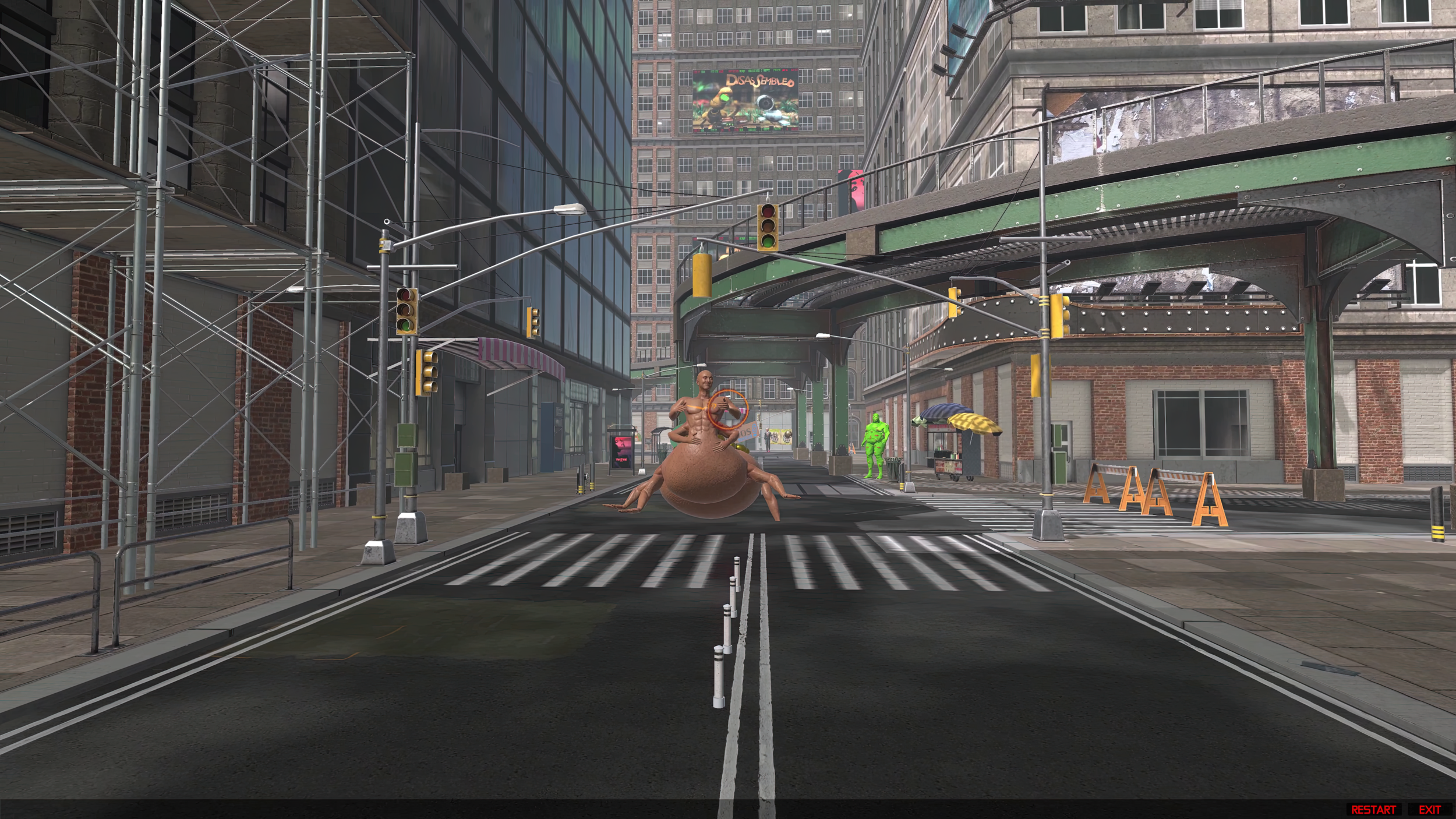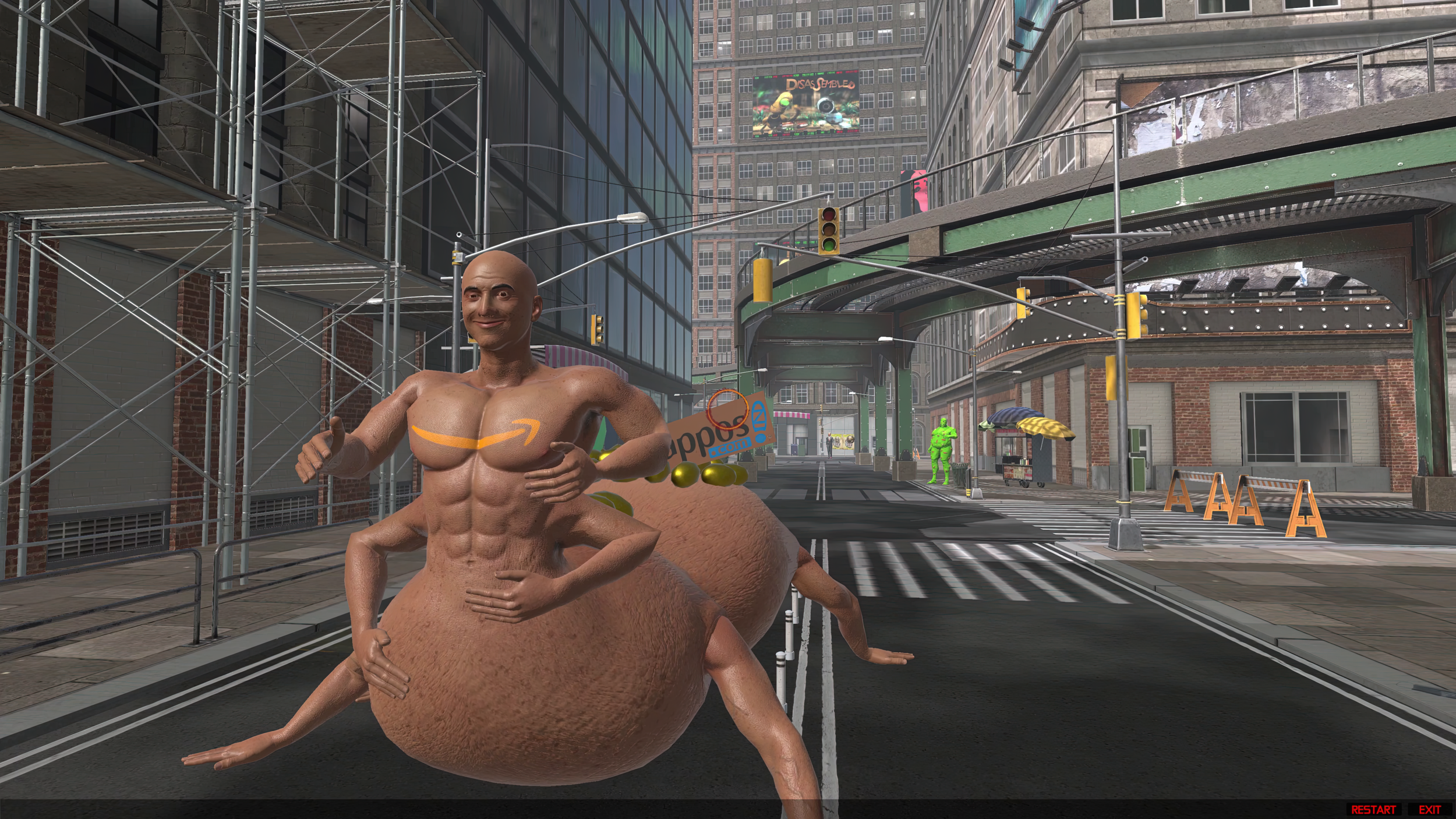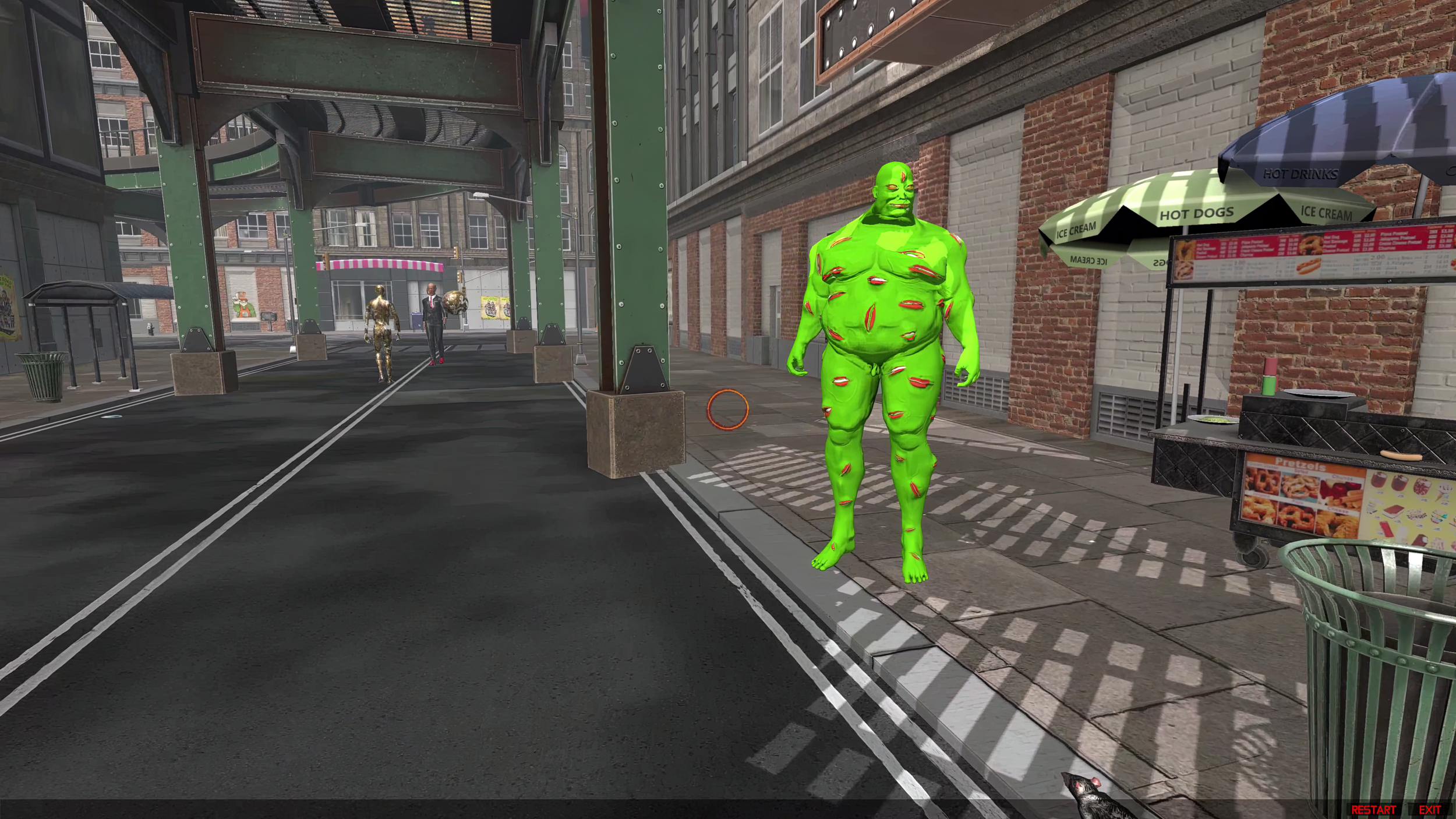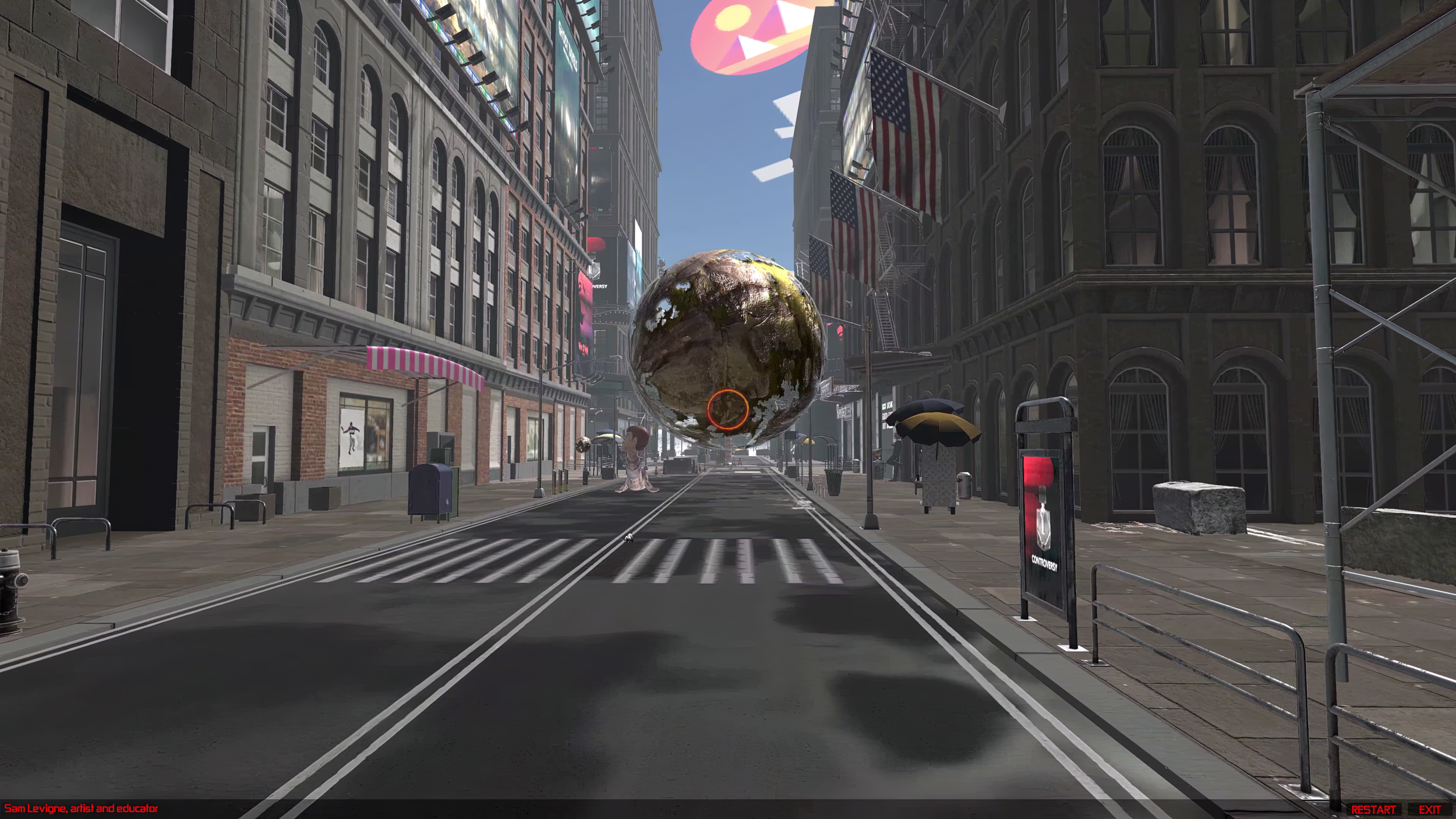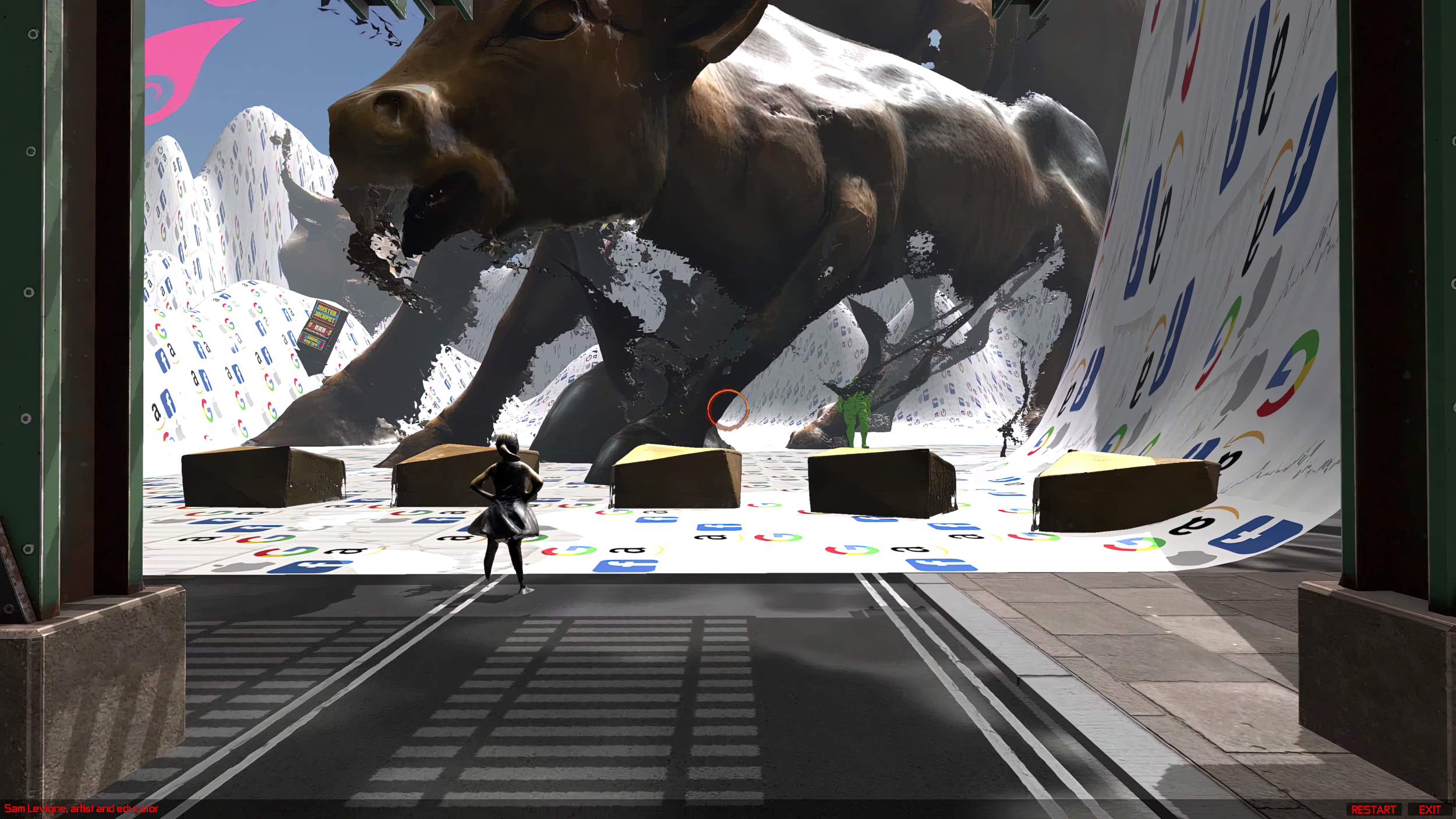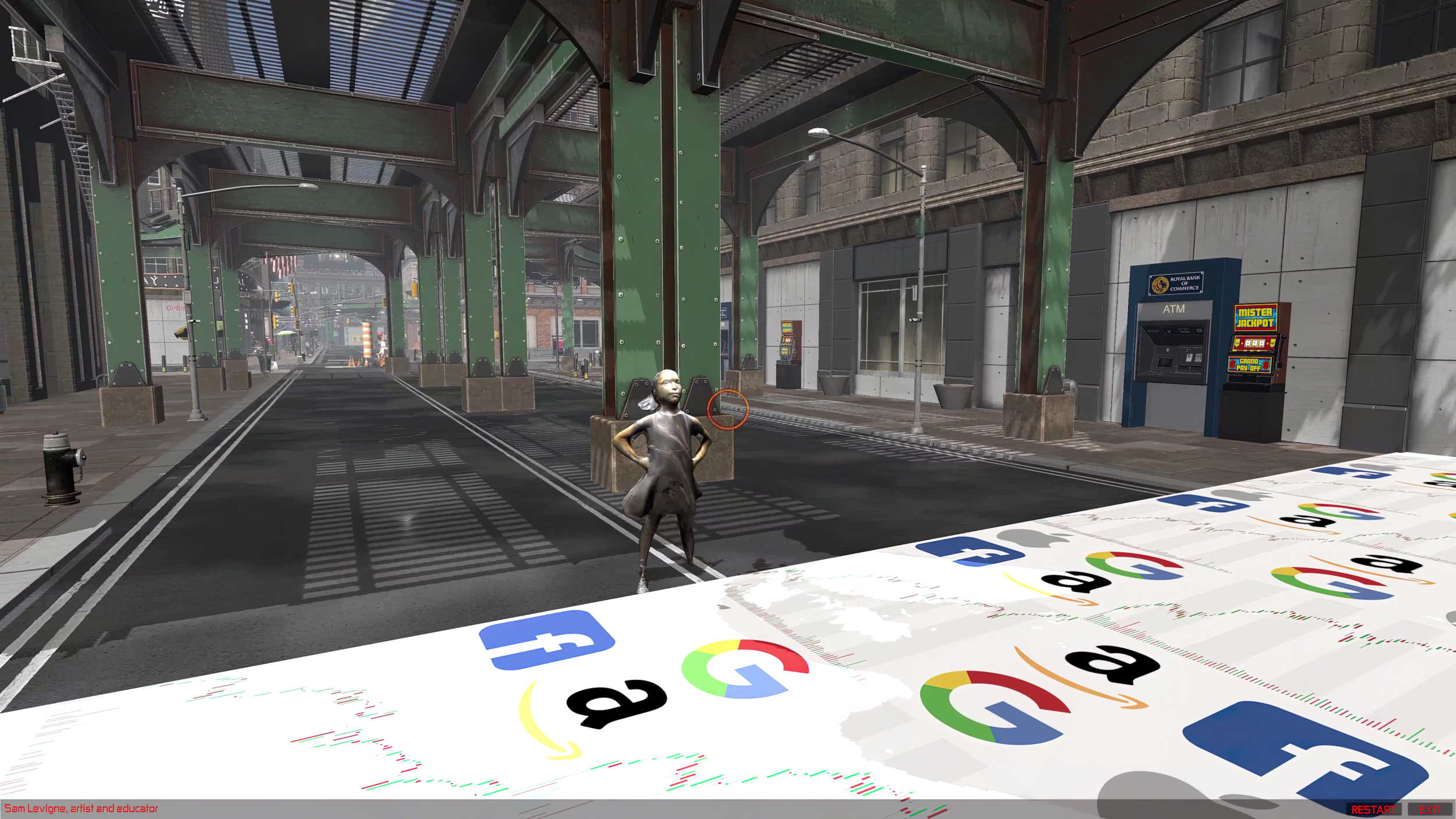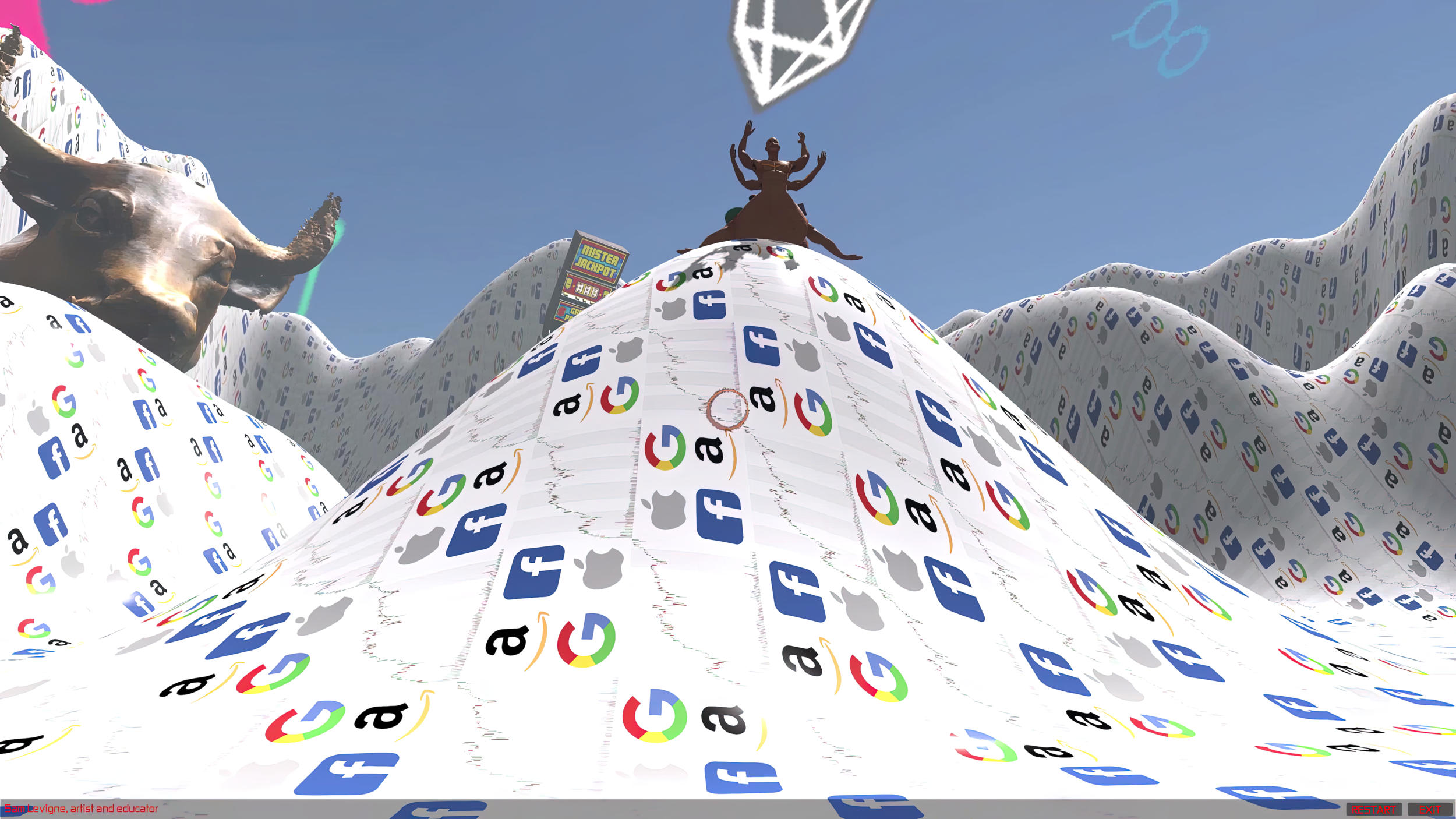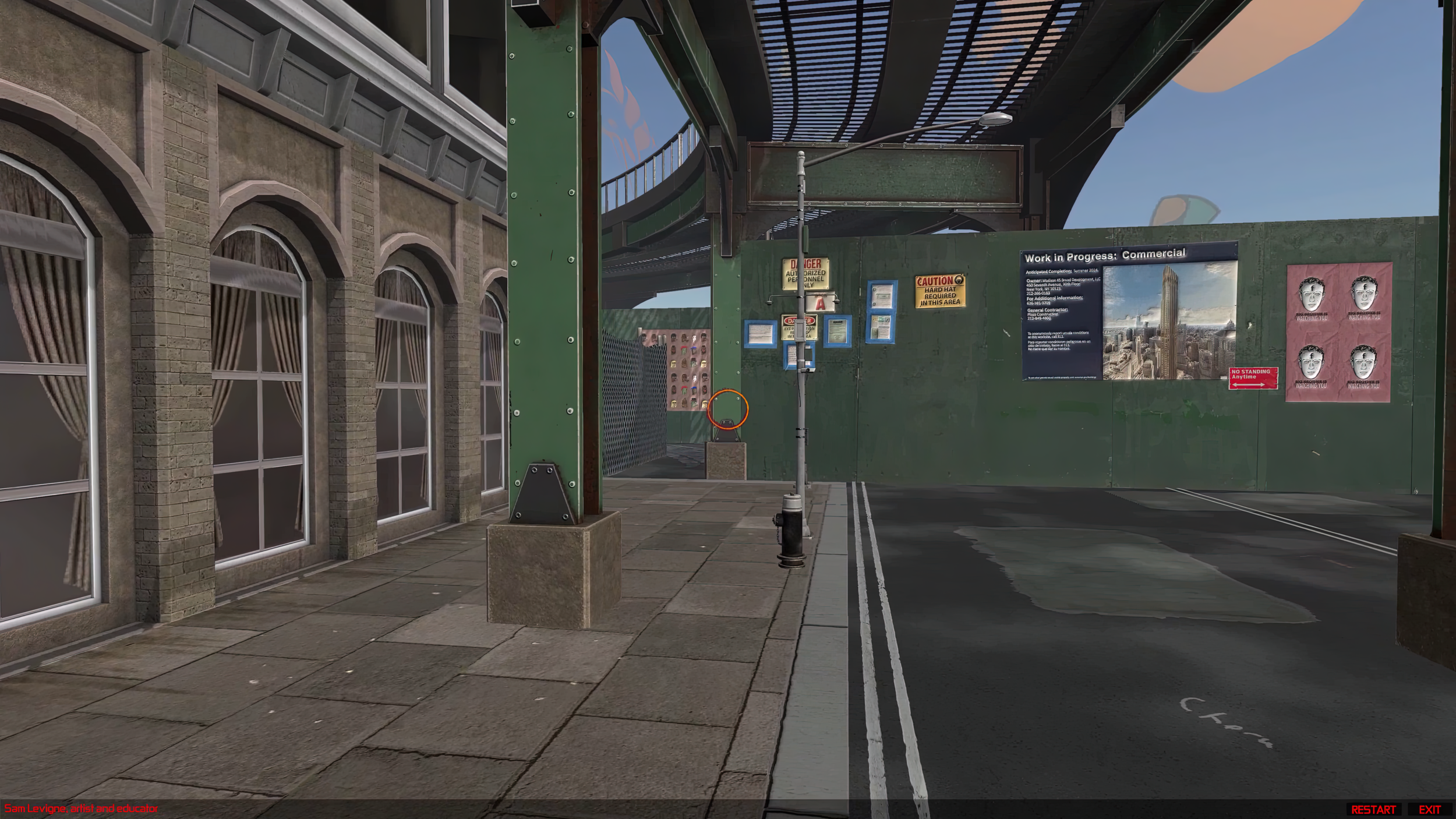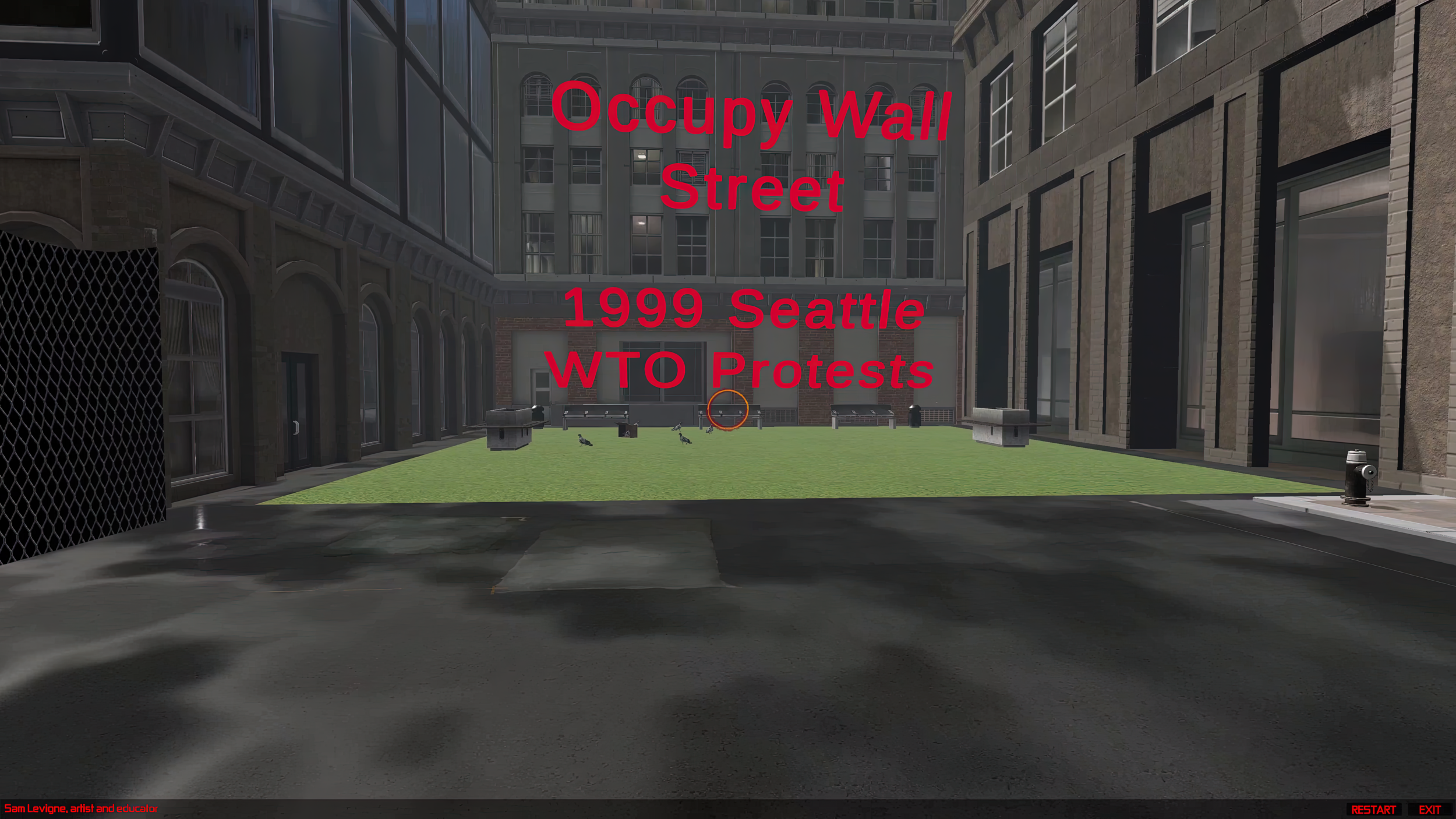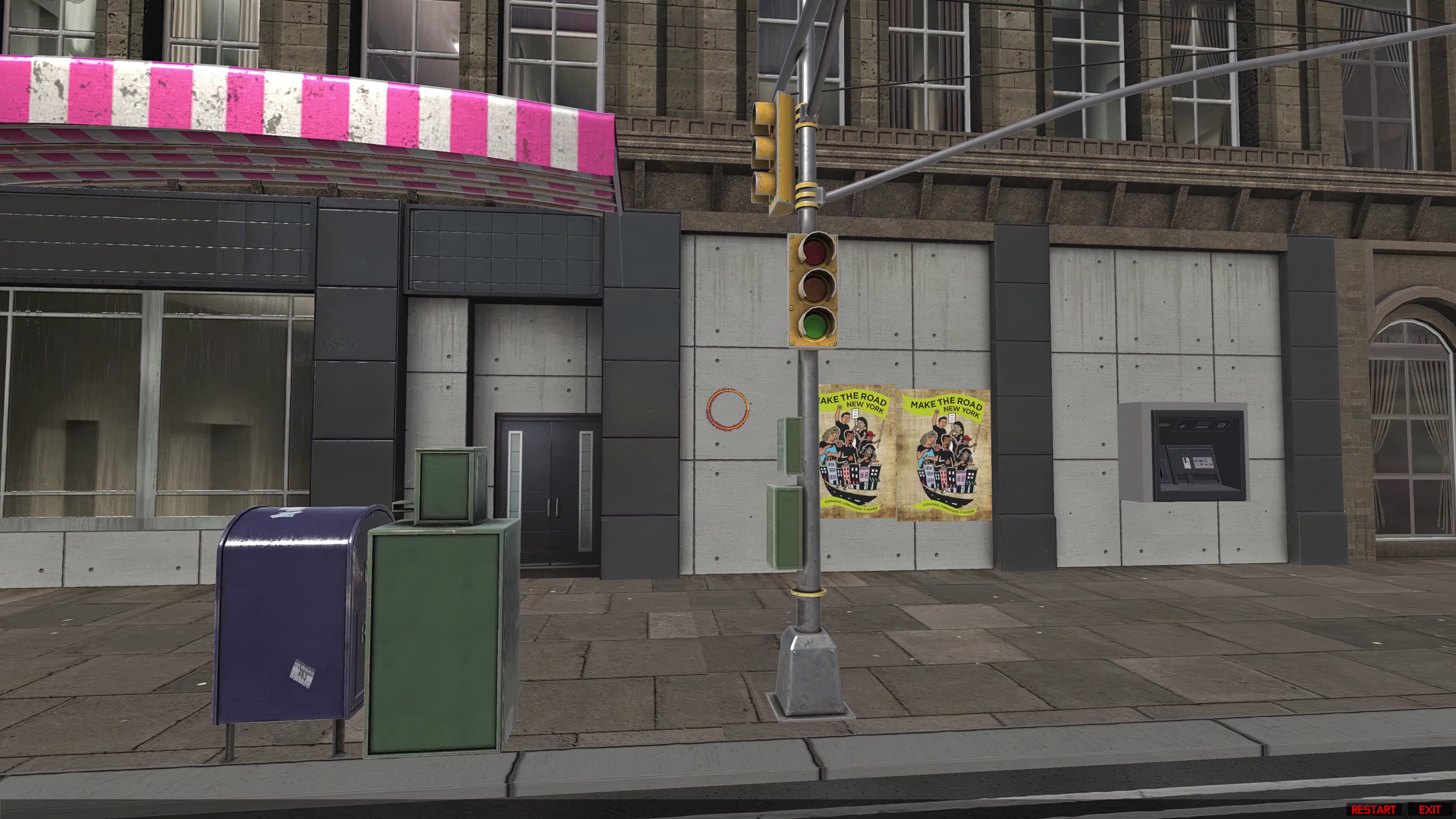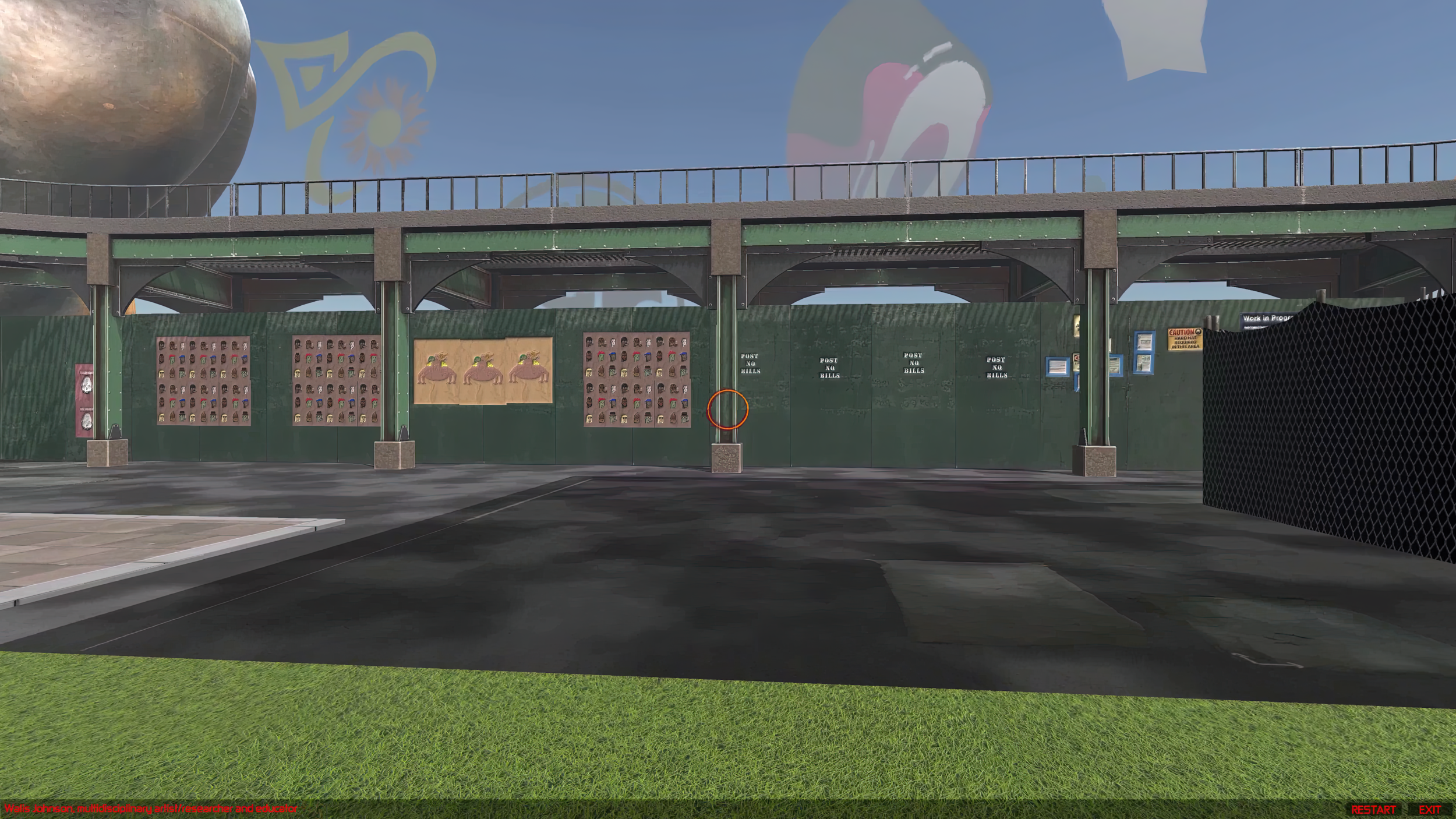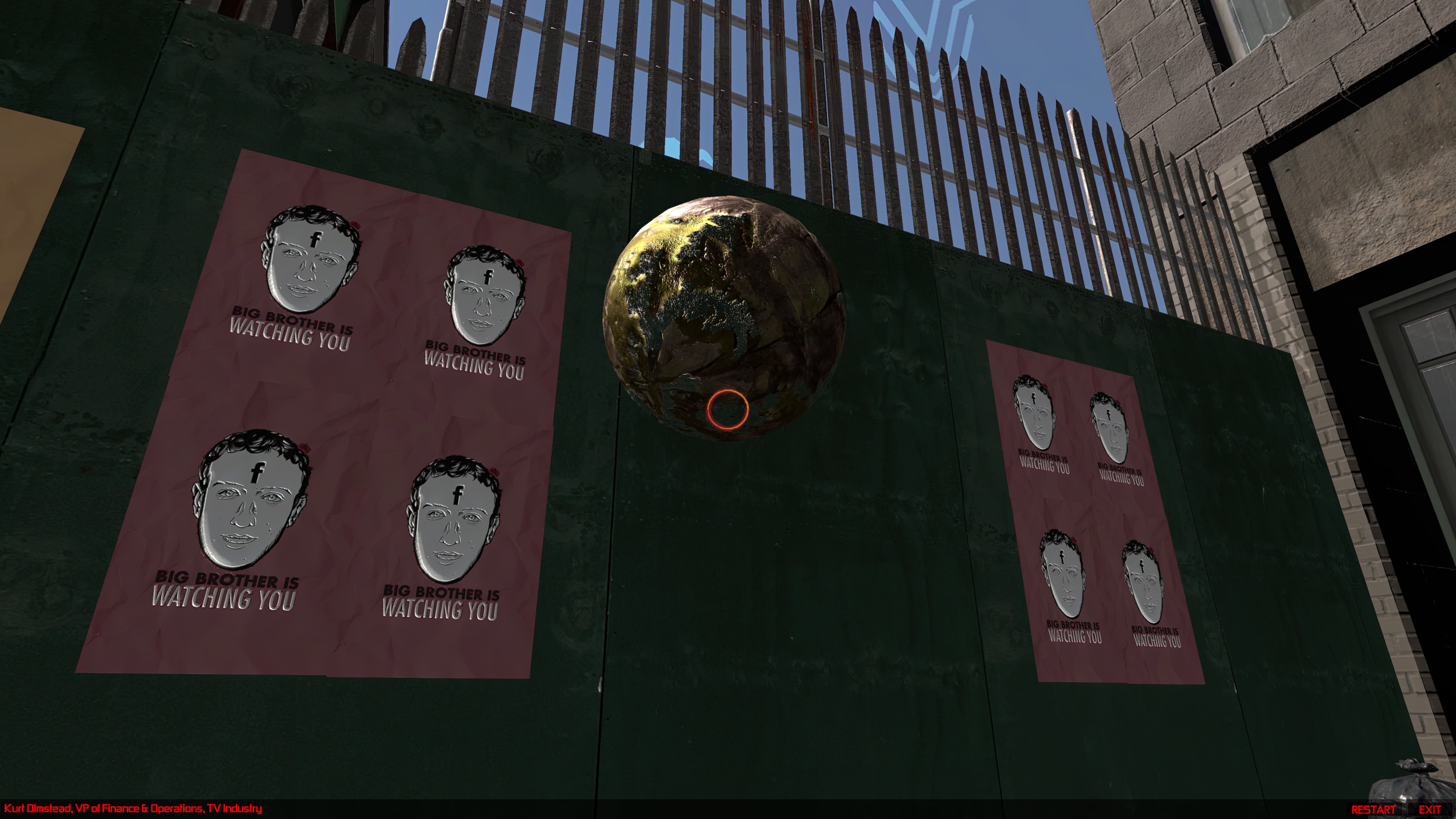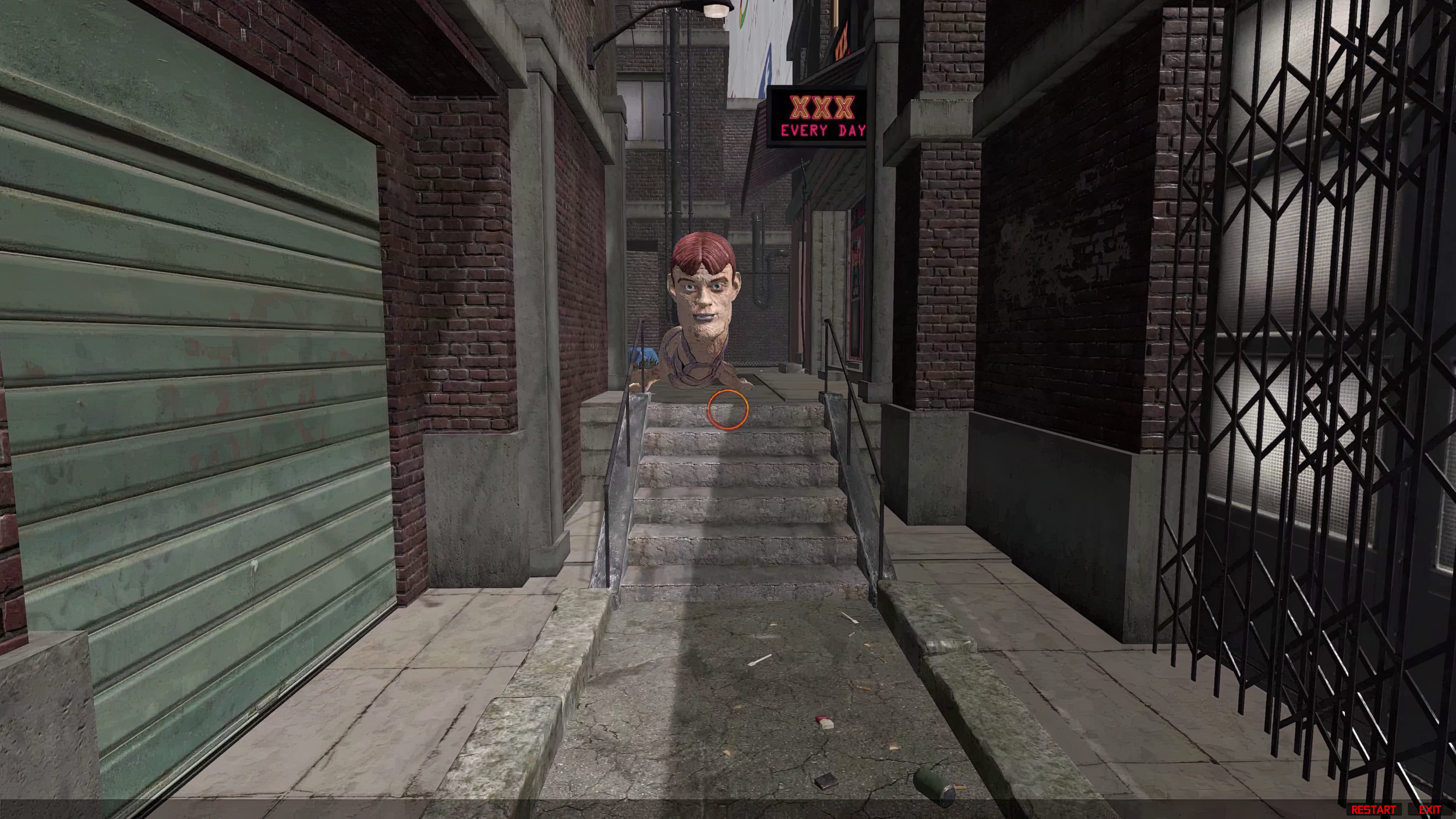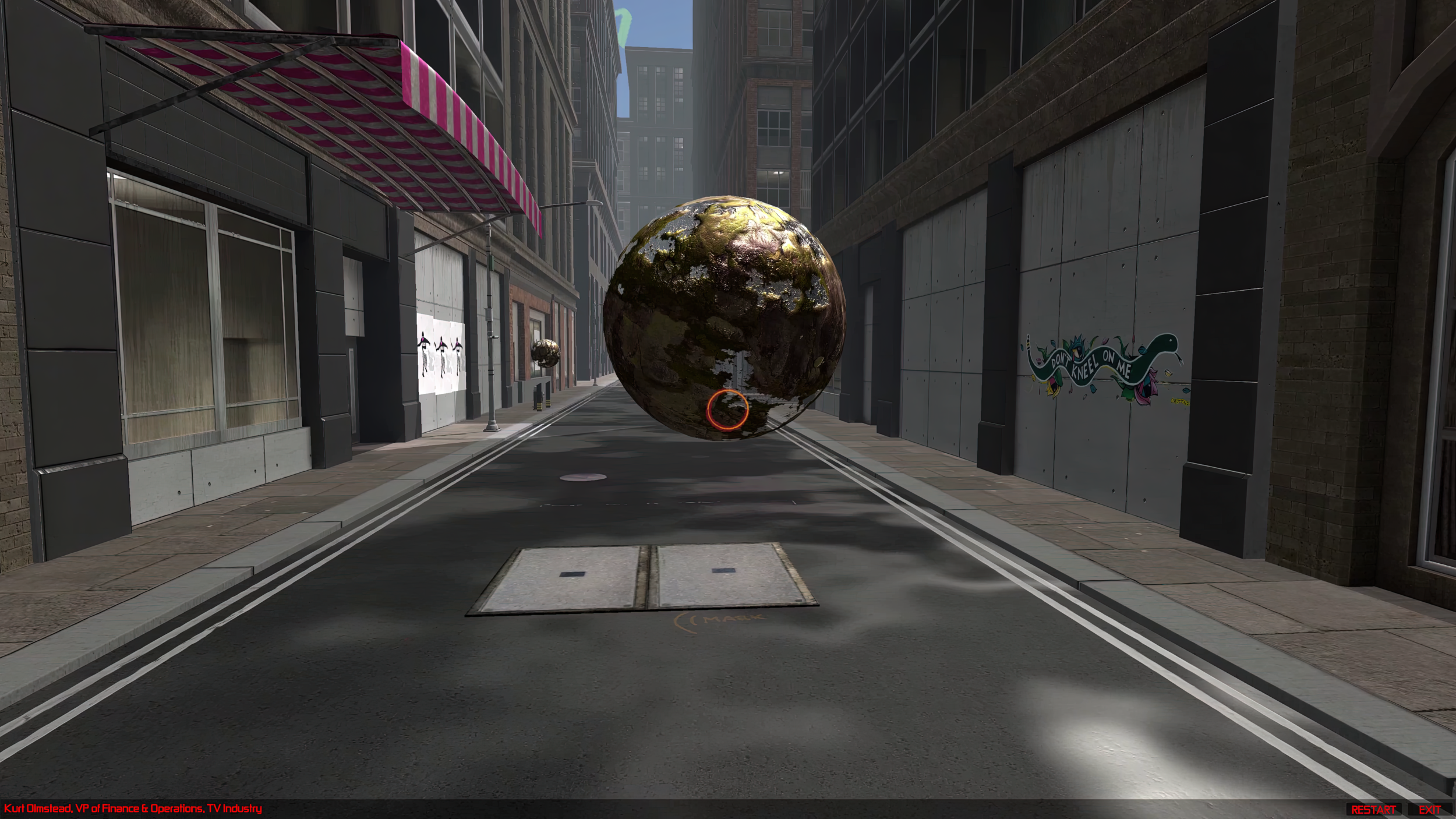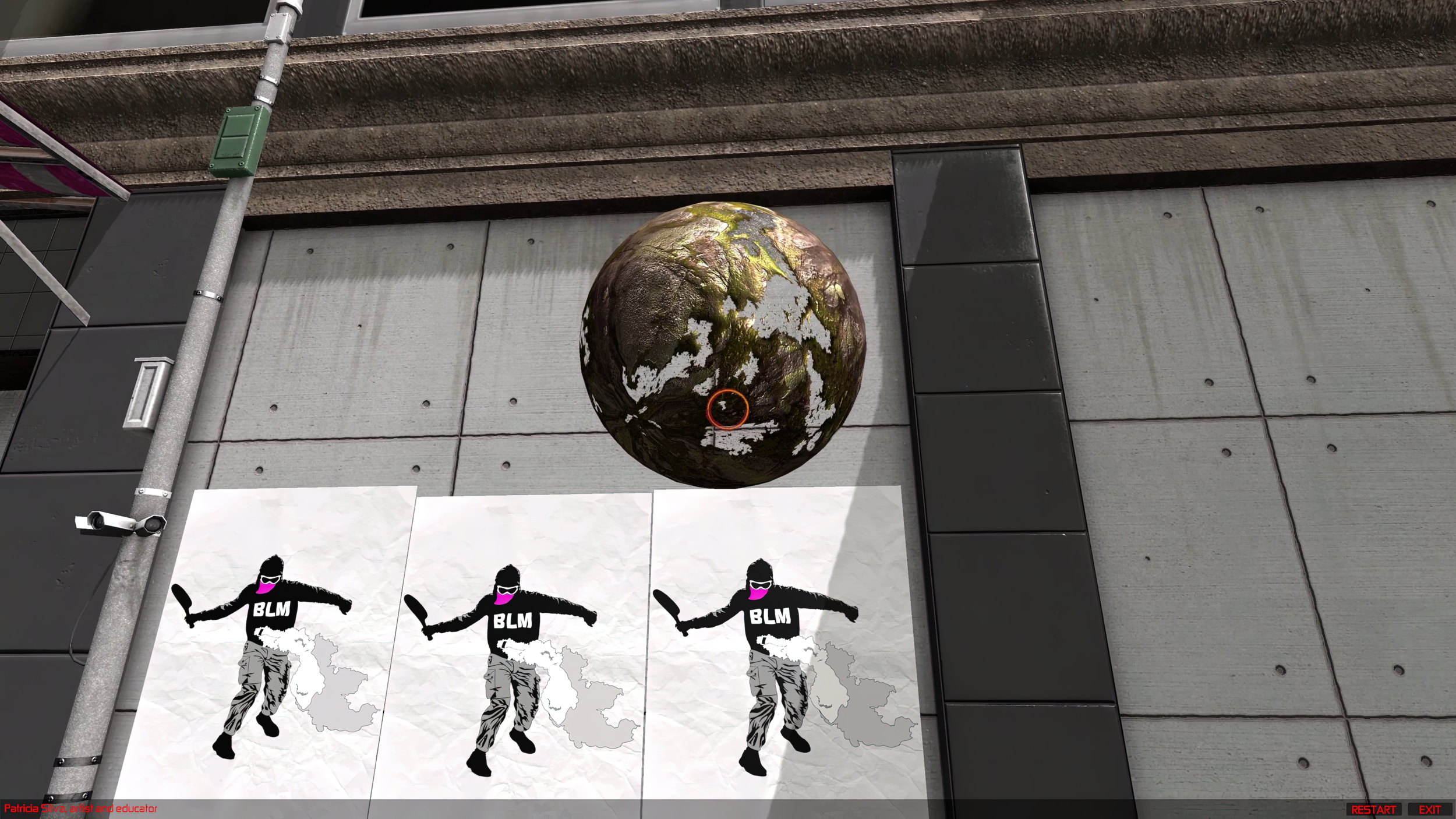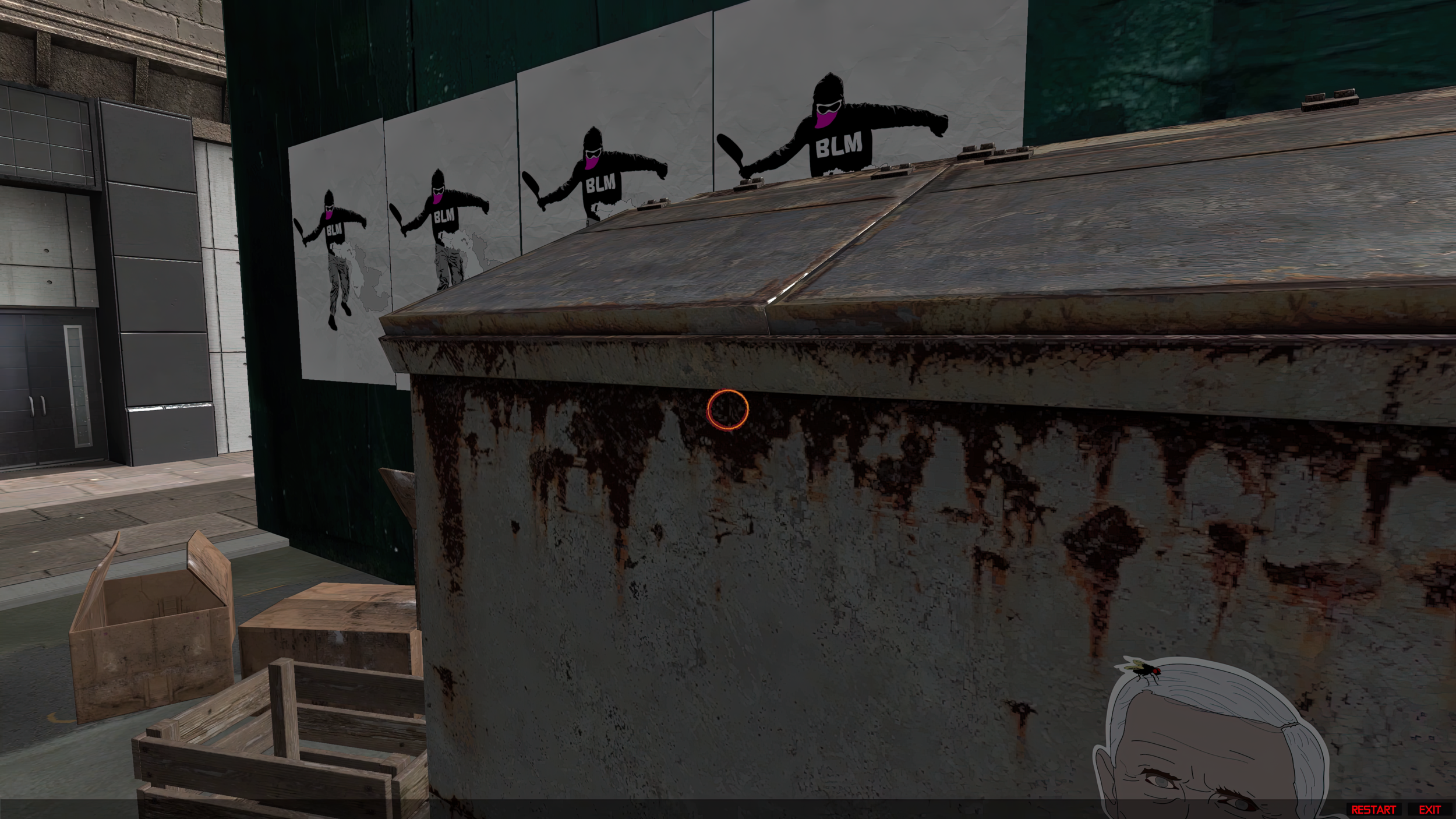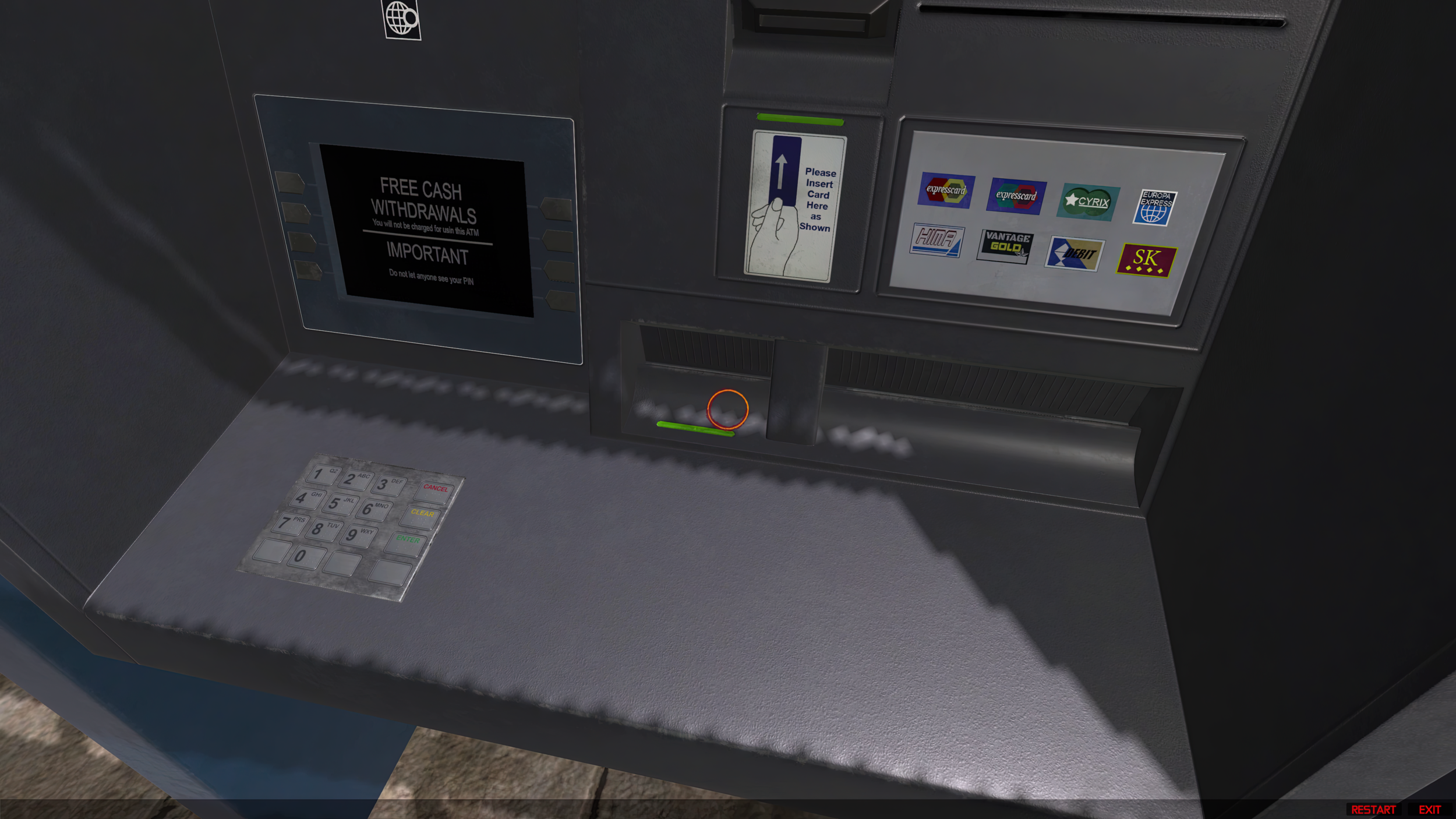FINTECH FOR THE PRECARIAT
digital video (3840 x 2160), color, sound, 11’ 37”, 2017, United States
Created by Ricardo Miranda Zúñiga, 2021
FinTech for the Precariat is an immersive urban environment populated by Greed, Lust, Gluttony, Envy, gig workers and twelve voices from New York City’s financial spectrum. As the user wanders around this environment, she stumbles upon its inhabitants — from financial brokers to recent college grads to computer programmers and cultural workers —, gaining an understanding of their financial perspectives. It has been projected that the 2020s will be the decade of the “FinTech Revolution”. This marketing hyperbole is on the heels of many such revolutions sold on the broken promises of democratization and prosperity for all. FinTech for the Precariat asks a simple question: Who are the winners and losers in this “game”?
Ricardo Miranda Zúñiga is a new media artist. He approaches art as a social practice that seeks to establish dialogue in public spaces. Zúñiga received a B.A. in Practice of Arts and English Literature at University at California, Berkeley, and later an M.A. in Fine Arts a from Carnegie Mellon University. Born in San Francisco in the early Seventies in a family of immigrants from Nicaragua, Zúñiga’s practice explores such themes as immigration, discrimination, gentrification, globalization, and commodification. His works have been exhibited internationally, often behind the contexts of art galleries and museums.
Matteo Bittanti: FinTech, a portmanteau of financial technology, has been described as “the technology and innovation that aims to compete with traditional financial methods in the delivery of financial services” and “an emerging industry that uses technology to improve activities in finance”. In your latest work, fintech is cast as another iteration of snake oil. In their recent book Failure, Arjun Appadurai and Neta Alexander discuss the “broken promises” of technology and finance at length. They write that, on the one hand, “That Silicon Valley has come to rely on delayed promises is made obvious by the fact that many of its most successful companies have failed to produce profits or have only become profitable after many years”. Wall Street commodifies failure as well, by turning it into a commodity for the elites, and exploiting “the relation between risk, uncertainty, and profit”. Wall Street’s ultimate goal, with the help of Silicon Valley, is the financialization of life, which is the culmination of the neoliberal project. Can artists raise awareness about this vicious circle of confidence games or is resistance purely performative, therefore futile?
Ricardo Miranda Zúñiga: I don’t believe that any energy put forth in earnest is futile. Perhaps the work does not seemingly change anything, but change takes time and when an artist elects to research a social issue, reflect upon it and undertake a creative work that is well-informed, that a single artist is most likely a tiny part of a greater force. One of my favorite interviews for FinTech for the Precariat was with cultural producer and educator Walis Johnson. One may listen to a portion of this interview when walking into a corporate park that is tucked between buildings. In her discussion, Johnson links the Occupy movement with Black Lives Matter as she points out that change takes a long time. I accompanied this interview with floating text that rises from the ground to the sky. This text presents a timeline from 1999 Seattle WTO Protests near the ground to Occupy Wall Street to Black Lives Matter to STRIKETOBER to Protecting the Right to Organize. I could have probably skipped STRIKETOBER, however, I do feel that there is a line of social progress from the 1999 Seattle WTO Protest to Occupy to BLM to the current PRO Act that has passed the House of Representatives and has not passed the Senate and may never become law. However, the fact that this act has been proposed after decades of labor being undervalued and the rights of workers stolen reflects a significant change. Countless artists played a role in the WTO protests and Occupy and BLM. These are artists that helped establish a culture and that also documented and reflected upon these movements. Any artist that believes a creative work will single-handedly affect change should probably switch careers.
Matteo Bittanti: Can you describe the genesis of Fintech for the Precariat? Why did you choose a video game, an interactive medium, to specifically address the theme of fintech? Is that because the so-called finance world is a completely virtual, apparently playful, gamified realm, hence digital environments are the most appropriate context to experience its many contradictions? Also, how did the pandemic contribute to the spread of this new gold rush? I’m also thinking about other ongoing scams, like NFTs, Web3 and the likes...
Ricardo Miranda Zúñiga: FinTech for the Precariat is not a game, it is a wandering world application that has game play elements and is produced through a game engine, but it’s not a game. I do very much like your association between Wall Street/the finance world and a virtual, gamified realm! So I’m going to embrace your point and say yes, the game space was the most appropriate medium for the topic!
Matteo Bittanti: Fintech for the Precariat reminds me of a previous work of yours, A Geography of Being, which deals with the sense of displacement that immigrants – but also first generation citizens such as yourself – experience. The game simulates the plight of moving to another country and incorporates interviews with young immigrant activists from India and Ecuador. Like A Geography of Being, Fintech for the Precariat is, by all means, an interactive documentary in which technology and the street play a key role. What do you like most about this genre or format (i.e., interactive documentary)? Is the fact that the viewer is granted some kind of agency – she can explore the environment rather than following a predetermined path for instance – its greatest appeal as an artform? Or is agency overrated, another broken promise of technology?
Ricardo Miranda Zúñiga: I think it’s a lot more fun than a single-channel documentary. It’s more fun for me to make and I think more fun for others to engage with. However, I’m not sure it’s very effective in so far as shedding light or sharing perspectives on a topic, because the player can get lost in the game play or the environment and entirely miss the point of the project or stop listening to the voices inhabiting the game space!
Matteo Bittanti: As I was reading the accompanying text for Fintech for th Precariat on your website, I was struck by the fact that originally, you wanted to incorporate pigoons, transgenic pigs bred to grow replacement organs for humans first introduced by Margaret Atwood in her novel Oryx and Crake, a favorite of mine. Was it a technical constraint, a legal issue or something else altogether that prevented their appearance in your game? Were there any other issues that you faced in the development process?
Ricardo Miranda Zúñiga: The pigoons didn’t make it due to budget restraints. I’m not a 3D artist, so I had to send my 2D illustrations to a 3D artist to create the 3D version and accompanying animations. I could only budget a set number of characters – Greed, Gluttony, Envy, Lust and the Gig Worker depleted my budget. I’m still waiting on the Gig Worker!
Matteo Bittanti: Can you discuss your original inspirations for the deadly sins that infest your virtual world, such as Lust or Greed? For instance, the Greed Minotaur looks suspiciously similar to Jeff Bezos, while Lust, a divertissement on a sculpture by Ludwig Linzinger, is described as an “STD ridden penis and testicles (that) glides along the floor with four small penis-like legs and has the enthusiasm of a perky dog”. What about the other vices?
Ricardo Miranda Zúñiga: Gluttony immediately popped into my head. I’m a very literal thinker and the image of a large naked male figure covered with chewing mouths immediately came to mind when considering Gluttony. For the others, I searched online, initially looking at European medieval representations of the deadly sins and that is when I found Giotto’s 1306 representation of Envy, an old woman carrying a bag of coins with demon horns, extended ears and a snake emerging from her mouth to eat at her eyes. I merely updated Giotto’s Envy to be a middle-age dapper businessman. And yes, Greed is absolutely Jeff Bezos and his body is modeled after Amazon Spheres, the headquarters in downtown Seattle.
Matteo Bittanti: For this project you interviewed a variety of individuals belonging to different yet contiguous spheres: tech artists, cultural workers, members of the precariat, recent college graduates, artists, financial specialists, and educators. What struck me when I listened to their voices is the huge divide between a small minority (the “haves”) and an increasing majority of “have nots”. It sounds like more and more people are not sharing the same reality any longer, hence their radically different interpretations of the contingent moment. Moreover, it sounds like technology, far from providing a solution to the problem, is one of the main catalysts. What do you think will be the outcome of this increasing social, cultural, and economic polarization, in the United States?
Ricardo Miranda Zúñiga: Honestly, between eight years of Obama, four years of Trump, two years of Pandemic and counting, it’s difficult to imagine what happens next. I agree with Sam Lavigne’s assessment that the Democrats are pro-Wall Street as are the Republicans. Although I fear that the divide will continue to grow, I do believe in the movements that I mentioned earlier linking the 1999 WTO protests to Occupy to BLM to greater workers’ rights. I feel that there is an ebb and flow in conservative and progressive values as well as in the accumulation of great wealth and growing disparity and that disparity will be tempered. 130 years ago the rise of the Robber Barons and U.S. industrialization helped lead to workers’ unions and better labor practices. The Great Depression helped establish Keynesian economics and social nets for the poor and middle class. This ongoing era of Friedman, Reagan, Thatcher neoliberalism and mass privatization is being strongly challenged on all sides. Unexpected demographics are beginning to recognize the possibility of Modern Monetary Theory. The very wealthy will remain wealthy, however, I feel that we are entering a new era that seeks to place safeguards for the “have nots,” or so I hope.
Matteo Bittanti: It’s been twenty years since my first encounter with your work. I still remember playing Vagamundo. A Migrant’s Tale online back in 2002. Why did you decide to incorporate game design into your practice? Can you describe your own, personal relationship to video games? And how did it change or evolve since the early Aughts?
Ricardo Miranda Zúñiga: As a child of the 1970s and 80s, video games were a rich part of my upbringing. My parent’s could not afford a video game system when they first became available, so I spent many hours at friends’ homes playing on their Atari 2600 in the late ‘70s as well as going to arcades. Again, not having much money to spend on these diversions, I needed to make the most out of a quarter, so I became very good at Ms. Pac-man and could cycle through all the levels, until the speed of the game generally became the reason behind the eventual end. The first system that I had at home was a Mattel Intellivision which my brother and I as well as friends spent endless hours playing. Amongst my favorite games were Pitfall and Utopia. Pitfall is an early platformer in which the avatar collects treasures while avoiding crocodiles, scorpions, tar pits and other obstacles, whereas Utopia was a strategy game that one played against one other player or the computer. You were given an island and a budget to build a society. You had to decide where to spend your purse – between schools, hospitals, agriculture, industry, fishing, war boats…. One could elect to attack the other island and try to conquer it. I mention these two particular games, because they are representative of what I find so engaging about games. In the former, you employ your nimble finger reflexes to keep your avatar alive and collect treasure while the latter forces you to assess your resources to create a thriving society that is nourished, educated, protected and cared for. Both games may evoke a sense of narrative – one inspired by Indiana Jones, the other by civilization and human history. Video games combine animation, sound and interactivity to capture one’s attention and allow one to lose themselves in the flow of the game.
While spending endless hours on these videogames, I was also a first-generation Nicaraguan American and with the majority of my family still in Nicaragua, I was well aware of the Sandinista Revolution that was soon followed by U.S. intervention due to the Reagan administration and Cold War fears. By 1983 at the age of 12, I was politically active and the following year, I volunteered for the Walter Mondale and Geraldine Ferraro candidacy, initially merely gathering signatures on the street for their campaign. The Reagan landslide victory, while knowing that this administration was guilty of violence and death in a very small and powerless country, pulled me away from political interests to more creative forms of activism and communication. These are the experiences that fed the desire to creatively share research and critical perspectives.
Computer-based technologies are a powerful medium for creativity and communication, so I try to remain engaged and teach myself new software that facilitates the creation of works that I wish to realize. My programming skills are limited so I depend on the work of others to realize interactive works. In the late 1990s and early Aughts, Flash was the tool that I employed because it worked in the browser. Before Flash, I used Director, however, who was going to download a self-contained application? It would be fine for an installation, but I wanted to produce work that the widest number of people could access, so Flash with its browser Flash Player seemed like the best option and I used it for several years. Eventually as Flash disappeared, I taught myself Unity and began to overcome my fear of 3D. Although I’ve used Unity to generate a few virtual reality projects, I question the enclosure of the head mount and whether or not a networked VR app is truly social. Of course, the advantage of a game engine like Unity is that it can facilitate publishing to many platforms from VR to desktop to the browser. Although the technologies have changed a great deal and become more sophisticated, the desire to employ the human voice, storytelling, sound, animation and interactivity to trigger reflection remain consistent in my practice.
Matteo Bittanti: I find remarkable that the disappointment following Mondale’s failed campaigns and the subsequent victory by Ronald Reagan, which ushered the tragic ascent of neoliberalism in the United States led you to pursue art and activism rather than conventional politics. Among other things, neoliberalism normalized what we now call entreprecariat, which is the aspirational manifestation of the precariat. In his book Entreprecariat, Silvio Lorusso describes the unholy connection between entrepreneurship and the precariat as “a worldview, an interpretation of reality that orients behaviour” which combines “exploitation and liberation” and thus can be ultimately understood as “an exploitation of liberation”. He writes: “The pressure of the entreprecariat does not just demand the constant upgrade of traditional professional skills, but it invades the realm of character, making good humour, optimism and cordiality a competitive advantage to cultivate through meditative practices and behavioural psychology in the form of mobile apps.” What is the “entreprecariat”, to you?
Ricardo Miranda Zúñiga: Just before COVID-19 hit New York City, I built a gaming PC with my 11-year-old son. Through the height of the pandemic, the PC turned out to be an absolute necessity. At the time, he loved playing Fortnite and he got into the habit of screen recording some of his game play. He would then send these screen recordings to his phone so that he could post them to TikTok where he quickly gathered a following of similarly interested users. Capitalism, the home computer, the internet, the smart phone, social networks have coalesced to create individuals that measure themselves against others for everything from careers, material things, followers, clout… anything that can be posted and shared to generate some sort of measure. The entreprecariat obsesses over the next great idea while perhaps putting aside stability. Self motivation, drive, and hard work are not new: they have been key features since industrialization. So many people juggle a job while working into the night to realize their personal vision. However, with the rise of the entreprecariat, there is something different as many external forces have descended upon the individual to solicit this energy. And unfortunately, for the vast majority of the entreprecariat it is companies that are reaping most of the rewards. The injustice of the entreprecariat is the imbalance of the distribution of capital. If people were justly rewarded for all their time and energy and companies whether Meta or Google would more fully distribute their gains, perhaps we could merely return to entrepreneurship and cut out the precariat part for the vast amount of people that depend on social networks as a means to launch a career that is digital in nature.
Ultimately, as with many things, I think that education and transparency are at the heart of the issue. Young people may be naively seduced to wield their dance skills or comedic delivery to gather a following on a social network and monetize their skills. This may be fine and even productive, however when companies begin to reach out to these individuals, whether it’s an auto message or a unique solicitation, companies should be transparent about their incentives and the real numbers of what they may gain from aiding the profile of that user/contributor. Gig workers on the other hand must be treated as contracted employees and be given the right to unionize and demand greater employee rights and even move on from a contracted role to a full-time employee with benefits. The entreprecariat is a symptom of greed and the nature of capitalism that may be transformed through education and activism.
Matteo Bittanti: Fintech for the Precariat was presented at The Clement and at The Museum of the Moving Image in New York in October 2021 before a live audience. What was the reaction like? How did it go? Were you surprised by any comments in particular?
Ricardo Miranda Zúñiga: I feel that both presentations were successful in that people, particularly young people, fully engaged with the project and appeared to enjoy it. While I was present and observing, I did not see anyone spend a minute or two and then walk away. People were curious and willingly spent time traversing the environment, trying to figure out the interaction and once doing so, listening to the voices.
FINTECH FOR THE PRECARIAT
digital video (3840 x 2160), color, sound, 11’ 37”, 2017, United States
Created by Ricardo Miranda Zúñiga, 2021
Courtesy of Ricardo Miranda Zúñiga, 2022
Narrator: Namakula Nasejje Musoke
Interviews featured in the video, in order of appearance: Sam Levigne, Walis Johnson, Kurt Olmstead, Patrica Silva
3D Artist: Rohan Singh
Sound Design: Dylan Marcheschi and Ricardo Miranda Zúñiga
Consultants: Francesca Panetta and Callum Prinster


